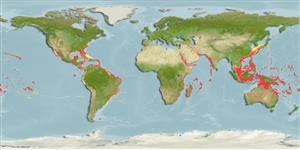Common names from other countries
Environment: milieu / climate zone / depth range / distribution range
Ecologie
; diepteverspreiding 0 - 139 m (Ref. 81020). Tropical
Indo-Pacific and Western Central Atlantic.
Length at first maturity / Size / Gewicht / Leeftijd
Maturity: Lm ? range ? - ? cm Max length : 8.0 cm WD mannelijk/geslacht niet bekend; (Ref. 800)
Found subtidally (Ref. 102838). Inhabits hard substrates by boring on rocks in shallow waters (Ref. 800). It is also found on fore-reefs (Ref. 87903). A grazing echinoid, predominantly scraping the substratum of turf algae (Ref. 125618). Feeds on algae (Also Ref. 129602) and small invertebrates. Associated with Athanas indica, which hides between its spines (Ref. 800). Associated with coral communities. Burrowing species (Ref. 129602).
Life cycle and mating behavior
Geslachtsrijpheid | Voortplanting | Kuitschieten | Eieren | Fecundity | Larven
Members of the class Echinoidea are gonochoric. Fertilization is external. Brooding is common, eggs are held either on the peristome, around the periproct or deep into the concavities on the petaloids. Life cycle: Embryos develop into planktotrophic larvae (echinoplateus) and live for several months before they sink to the bottom using their tube feet to adhere on the ground where they metamorphose into young urchins.
Schoppe, S. 2000. (Ref. 800)
Status op de Rode Lijst van het IUCN (Ref. 130435)
Status bij CITES (Ref. 108899)
Not Evaluated
Not Evaluated
Gebruik door de mens
| FishSource |
Tools
Meer informatie
Leeftijd/GrootteGroeiLengte-gewicht parametersLengte-lengte parametersMorfologieLarvenAbundantie
Internet-bronnen
Estimates based on models
Preferred temperature
(Ref.
115969): 23.3 - 28.8, mean 27.1 (based on 1386 cells).
Weerstandsvermogen
Hoog, minimale populatieverdubbelingstijd minder dan 15 maanden (K=0.4).
Kwetsbaarheid
Low vulnerability (10 of 100).
Prijsklasse
Unknown.
